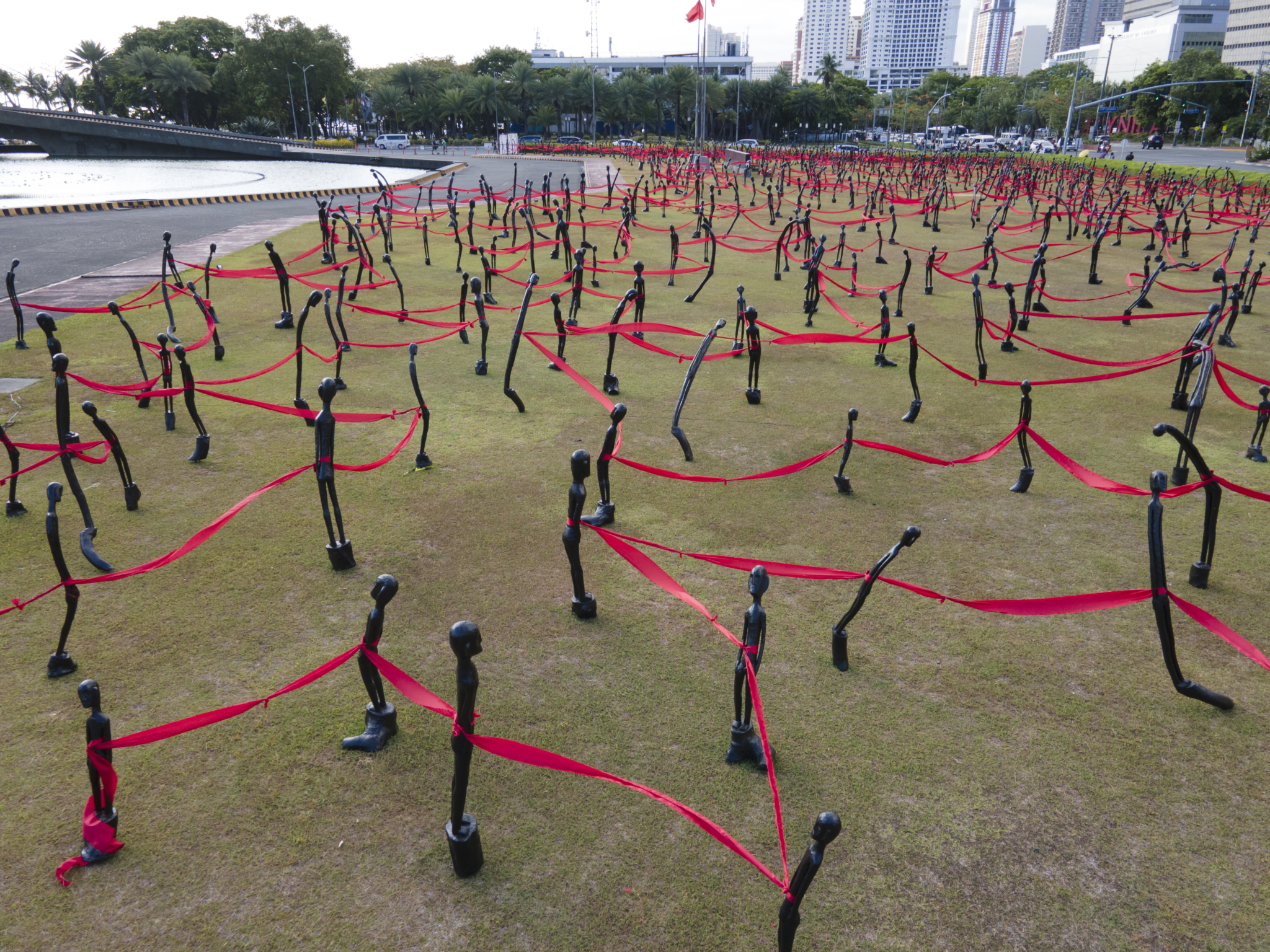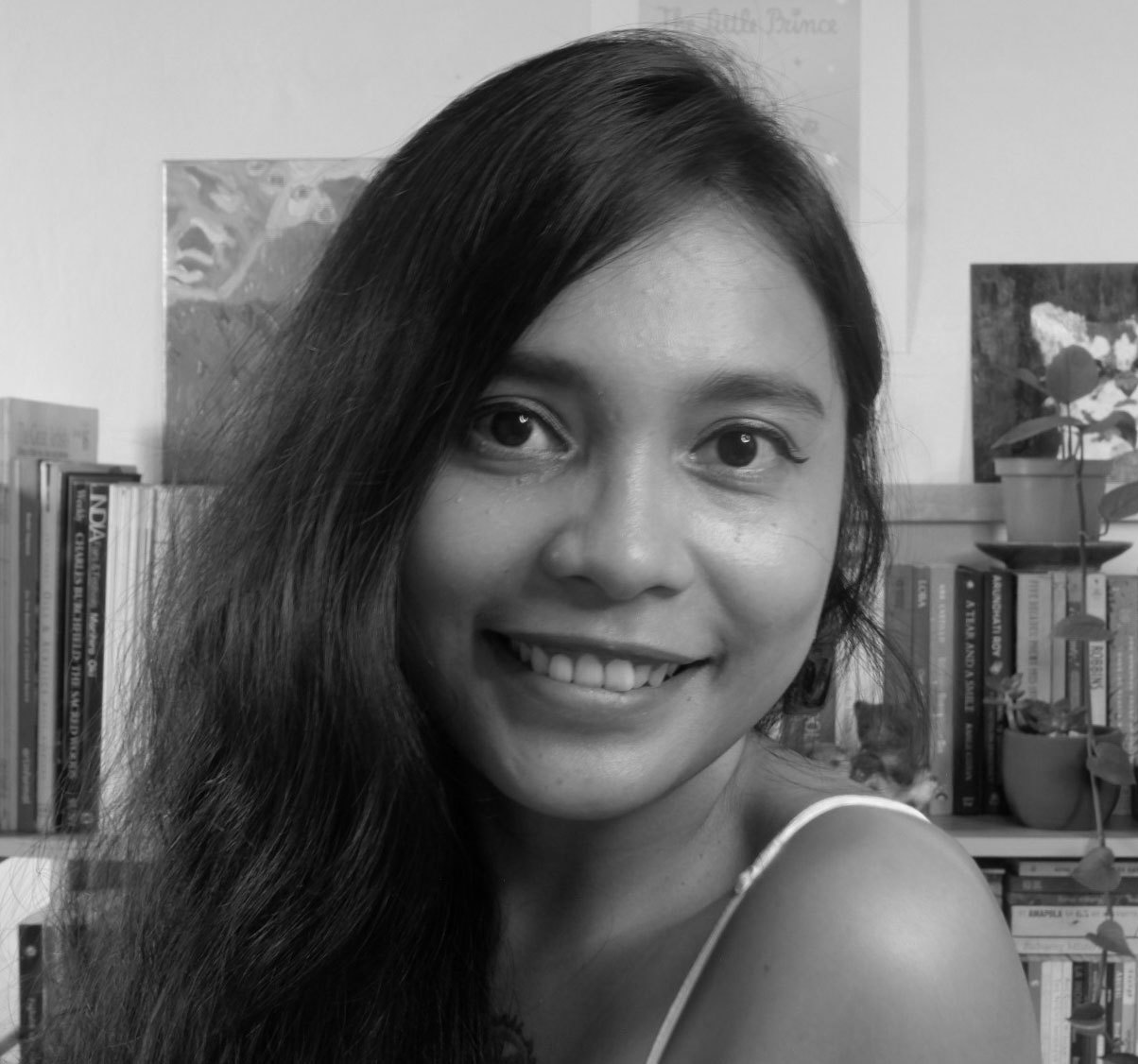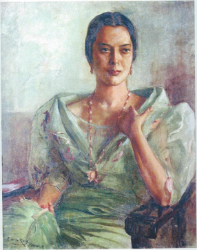It was the eve of the elections. I decided to go for a jog at the Cultural Center of the Philippines (CCP) Complex to view an installation I saw in passing a week before. Back then, the front lawn of the Tanghalang Pambansa was emblazoned with red ribbons that connected stretched-out umber figures. It took me a good while to process what I was witnessing: a forest fire in the middle of the city.
Entitled KAINGIN, the installation by Samar-born Jinggoy Buensuceso debuted last April 30, 2022 in commemoration of Earth Day. A thousand rice deities called bu’lul sprung from the green grass, each distorted to look like burnt matchsticks – a strong deviation from the customarily serene yet steadfast figures. These idols breathed new life into the ashes of trees, retelling their stories through a devourment by the fabric of fire. In the thick of the Philippine election season, there had been public outroar two days prior to the casting of votes, as the red ribbons that signified the forest’s untimely death were swapped out for pink – a move that the artist described as a “flame of renewal, hope, and love for Motherland”. Netizens were quick to point out hued partisanship towards VP Leni Robredo’s presidential bid. This change was short-lived, however, as the pink ribbons that linked each figure were removed the day after.
I can only surmise the feeling of discomfort and suffocation looming around the anthropomorphic figures in their convoluted postures, looking in all directions. The figures seem to empathize with my own setting smog of worry and restlessness. We all look lost in a place we’ve been planted in. Above us, the sun sets and crimson bathes the sky.
After casting my vote, I held on to my copy of I Know Why The Caged Bird Sings for comfort. The electoral anxiety ballooned a few hours later into a mixture of grief, confusion, and an unshakable feeling that I could only place as a loss of hope. The past few weeks have played out similar to the installation itself, that of collective destruction turning into a blaze of hope and its eventual loss.

A Separation of Art and State
Given the loud commentary on social media, particularly the chromatic nod to the Robredo campaign, there have been lengthy and zealous discussions on the separation of art and politics. The case for l’art pour l’art (art for art’s sake) has been present since the nineteenth-century, with artists denouncing the social contexts surrounding works in favor of their form and autonomy. Even then, works of art weren’t exempt from the internal and external politics that lead to their creation. They didn’t exist in a vacuum, and the discussions that sprouted often provided an accurate snapshot of truth and endless questioning. What fault then is to be given to a piece that provides an adequate commentary of its surroundings?
The Tanghalang Pambansa is the dictatorial parthenon to a dark time in our history. Its clean lines and weightlessness strike against the heavy concrete, much like the foreboding mirage of the Marcos Sr. presidency. To bring forth a vision in front of it, particularly this close to the elections, was a just juxtaposition for the atrocities of power.
Akin to Archie Oclos’s ...Ang Mamatay Ng Dahil Sa'yo (2018) found just around the corner, KAINGIN questions the capability of the state to bend the truth through an illusion of safety and progress. As the former shows the unidentifiable remains of a victim, the building behind it provides a foreshadowing of history repeating in the hands of different leaders. Establishments from the Philippine Brutalist Movement have cemented the legacy and reinstatement of the Marcoses. Public-owned properties are repeatedly used to forge forgetfulness in a nation, leading to justification for bloodshed and lack of adequate government response. Politicians have utilized architecture and infrastructure as a means to weaponize beauty, with the guns pointed at our fellowmen.
Reclamations of Environmentalism
Amidst the naked and dried-up bu’luls, a central all-consuming flame burned within a hearth of blood-red roots. This eternal ember remained a permanent fixture despite the numerous iterations of KAINGIN within its month’s stay. Picking up the narrative of Angud, the once seedlings from Junyee’s 2007 installation at the same front lawn have blossomed into a forest protest, denouncing man’s actions in claiming a land where they are only guests.
The sown driftwood and the eventual forest that grew from it both protest the illegal logging practices in the country. Given the electoral coloring of KAINGIN in contrast to its predecessor, its environmentalist notions aren’t diluted by the political contexts surrounding it. The Duterte administration’s blind eye towards irresponsible mining and logging, as well as China’s extensive reclamation activities, was worsened by a drug war that persecuted people maintaining safe farming and fishing practices. A representative ecosystem thriving on reclaimed land doesn’t take away its commentary on the government’s complacency in the natural disasters within this administration as well as the ones before it. The lack of appropriate response towards ecological protection in favor of massive building projects harkens back to the same edifice complex that created monuments at the expense of sacred lands from a dictatorial administration.
How, then, must we pay respect to the land we owe so much to? After the declaration of winners, a culminating ritual was held at the installation. Drums resounded as the statues amalgamated into small bonfires that lit the way towards the hearth. By nightfall, Buensuceso was bathed by light as he fulfills the role of the mumbaki, the sayer of prayers, performing the final rite for the rebirth of the calcine forest. The birds sang for the unknown, for freedom, or for dawn. An offering was made for the safe passage of the dead trees into new life, and I had only hoped that through this prayer, my country would be revived from an impending political forest fire.







